NCERT Solutions for Class 10 Maths Chapter 9 - Some Applications of Trigonometry (Exercise 9.1)
Page No 141
Q1: A circus artist is climbing a 20 m long rope, which is tightly stretched and tied from the top of a vertical pole to the ground. Find the height of the pole, if the angle made by the rope with the ground level is 30° (see figure).
 Ans:
Ans:
Known:
(i) Length of rope = 20 m (ii) Angle of rope with ground = 30°= ∠ACB
Unknown:
Height of pole Reasoning:
Reasoning:
AB = Height of the Pole
BC = Distance between the point on the ground and the pole.
AC = Length of the Rope (Hypotenuse)
We need to find the height of the pole AB, from the angle C and the length of the rope AC. Therefore, Trigonometric ratio involving all the three measures is sin C .
In ΔABC,
 Height of pole AB = 10m
Height of pole AB = 10m
Q2: A tree breaks due to a storm and the broken part bends so that the top of the tree touches the ground making an angle 30° with it. The distance between the foot of the tree to the point where the top touches the ground is 8 m. Find the height of the tree.
Ans:
Unknown:
Height of the tree
Known:
(i) Broken part of the tree bends and touching the ground making an angle of 30° with the ground. (ii) Distance between foot of the tree to the top of the tree is 8m Reasoning:
Reasoning:
(i) Height of the tree = AB + AC
(ii) Trigonometric ratio which involves AB, BC and ∠C is tan θ , where AB can be measured.
(iii) Trigonometric ratio which involves AB, AC and ∠C is sin θ , where AC can be measured.
(iv) Distance between the foot of the tree to the point where the top touches the ground = BC = 8 m
Solution:
In ΔABC,

Height of tree = 8√3 m
Q3: A contractor plans to install two slides for the children to play in a park. For the children below the age of 5 years, she prefers to have a slide whose top is at a height of 1.5 m, and is inclined at an angle of 30° to the ground, whereas for older children, she wants to have a steep slide at a height of 3 m, and inclined at an angle of 60° to the ground. What should be the length of the slide in each case?
Ans:
Unknown:
Length of the slide for children below the age of 5 years and elder children.
Known:
(i) For the children below the age of 5 years.
Height of the slide = 1.5m Slide’s angle with the ground = 30° (ii) For elder children.
(ii) For elder children.
- Height of the slide = 3m
- Slide’s angle with the ground = 60°
Reasoning:
Let us consider the following conventions for the slide installed for children below 5 years:
- The height of the slide as AC.
- Distance between the foot of the slide to the point where it touches the ground as AB.
- Length of the slide as BC
Let us consider the following conventions for the slide installed for elder children:
- The height of the slide PR.
- Distance between the foot of the slide to the point where it touches the ground as PQ.
- Length of the slide as QR.
(i) Trigonometric ratio involving AC, BC and ∠B is sin θ
(ii) Trigonometric ratio involving PR, QR and ∠Q is sin θ
Solution:
(i) In ΔABC,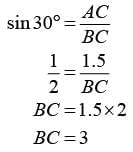
(ii) In ΔPRQ,
Length of slide for children below 5 years = 3 m
Length of slide for elder children = 2√3 m
Q4: The angle of elevation of the top of a tower from a point on the ground, which is 30 m away from the foot of the tower, is 30°. Find the height of the tower.
Ans:
Known:
(i) Angle of elevation of the top of the tower from a point on ground is 30°
(ii) Distance between the foot of the tower to the point on the ground is 30 m.
Unknown:
Height of the tower Reasoning:
Reasoning:
Let us consider the height of the tower as AB, distance between the foot of tower to the point on ground as BC.
In ΔABC,
Trigonometric ratio involving AB, BC and ∠C is tan θ.
Solution:
In ΔABC, Height of tower AB = 10√3 m
Height of tower AB = 10√3 m
Q5: A kite is flying at a height of 60 m above the ground. The string attached to the kite is temporarily tied to a point on the ground. The inclination of the string with the ground is 60°. Find the length of the string, assuming that there is no slack in the string.
Ans:
Known:
(i) Height of the flying kite = 60m
(ii) Angle made by the string to the ground = 60°
Unknown:
Length of the string
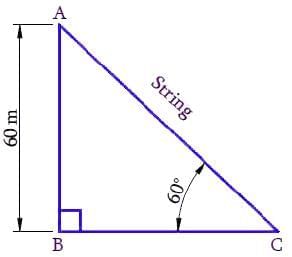 Reasoning:
Reasoning:
Let the height of the flying kite as AB, length of the string as AC and the inclination of the string with the ground as ∠C .
Trigonometric ratio involving AB, AC and ∠C is sin θ
Solution:
In ΔABC,
Length of the string AC = 40√3 m
Q6: A 1.5 m tall boy is standing at some distance from a 30 m tall building. The angle of elevation from his eyes to the top of the building increases from 30° to 60° as he walks towards the building. Find the distance he walked towards the building.
Ans:
Known:
(i) Height of the boy = 1.5 m
(ii) Height of the building = 30 m
(iii) Angle of elevation from his eyes to the top of the building increases from 30° to 60° as he walks toward the building.
Unknown:
Distance, the boy walked towards the building Reasoning:
Reasoning:
Trigonometric ratio involving (AP, PR and ∠R ) and (AP, PQ and ∠Q ) is tan θ [ Refer the diagram to visualise AP, PR and PQ ]
Distance walked towards the building RQ = PR - PQ
Solution:
In Δ APR
In Δ APQ

Therefore,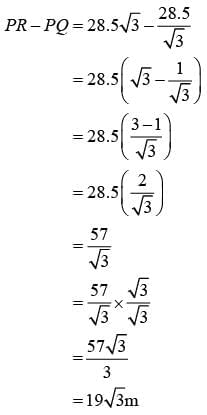
Distance the boy walked towards the building is 19√3 m
Q7: From a point on the ground, the angles of elevation of the bottom and the top of a transmission tower fixed at the top of a 20 m high building are 45° and 60° respectively. Find the height of the tower.
Ans:
Known:
(i) Angle of elevation from ground to bottom of the tower = 450
(ii) Angle of elevation from ground to top of the tower = 600
(iii) Height of the building = 20 m
(iv) Tower is fixed at the top of the 20 m high building
Unknown:
Height of the tower Reasoning:
Reasoning:
Let the height of the building is BC, height of the transmission tower which is fixed at the top of the building is AB. D is the point on the ground from where the angles of elevation of the bottom B and the top A of the transmission tower AB are 45° and 60° respectively.
The distance of the point of observation D from the base of the building C is CD Combined height of the building and tower = AC = AB + BC
Trigonometric ratio involving sides AC, BC, CD, and ∠D (45° and 60°) is tan θ
Solution:
In ΔBCD,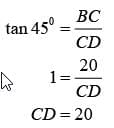
In ΔACD,
Height of the tower, AB = AC− BC
AB = 20√3 m - 20 m
= 20 (√3-1) m
Page No 142
Q8: A statue, 1.6 m tall, stands on the top of a pedestal. From a point on the ground, the angle of elevation of the top of the statue is 60° and from the same point the angle of elevation of the top of the pedestal is 45°. Find the height of the pedestal.
Ans:
Known:
(i) Height of statue = 1.6 m
(ii) Angle of elevation from ground to top of the statue = 60°
(iii) Statue stands on the top of the pedestal.
(iv) Angle of elevation of the top of the pedestal (bottom of the statue) = 45°
Unknown:
Height of the pedestal Reasoning:
Reasoning:
Let the height of the pedestal is BC, height of the statue, stands on the top of the pedestal, is AB. D is the point on the ground from where the angles of elevation of the bottom B and the top A of the statue AB are 45° and 60° respectively.
The distance of the point of observation D from the base of the pedestal C is CD Combined height of the pedestal and statue AC = AB + BC Trigonometric ratio involving sides AC, BC, CD, and ∠D (45° and 60°) is tan θ
Solution:
In ΔBCD,
In ΔACD,

Height of pedestal BC = 0.8 (√3+1)m
Q9: The angle of elevation of the top of a building from the foot of the tower is 30° and the angle of elevation of the top of the tower from the foot of the building is 60°. If the tower is 50 m high, find the height of the building.
Ans:
Known:
(i) Angle of elevation of the top of a building from the foot of the tower = 30°
(ii) Angle of elevation of the top of the tower from the foot of the building = 60°
(iii) Height of tower = 50m
Unknown:
Height of the building Reasoning:
Reasoning:
Let the height of the tower is AB and the height of the building is CD. The angle of elevation of the top of the building D from the foot of the tower B is 30° and the angle of elevation of the top of the tower A from the foot of the building C is 60°.
Distance between the foot of the tower and the building is BC.
Trigonometric ratio involving sides AB, CD, BC and angles ∠B and ∠C is tan θ
Solution:
In ΔABC,

In ΔBCD,
Height of the building 
Q10: Two poles of equal heights are standing opposite each other on either side of the road, which is 80 m wide. From a point between them on the road, the angles of elevation of the top of the poles are 60° and 30° respectively. Find the height of the poles and the distances of the point from the poles.
Ans:
Known:
(i) The poles of equal height. (ii) Distance between poles = 80 m
(iii) From a point between the poles, the angle of elevation of the top of the poles are 60° and 30° respectively.
Unknown:
Height of the poles and the distances of the point from the poles. Reasoning:
Reasoning:
Let us consider the two poles of equal heights as AB and DC and the distance between the poles as BC. From a point O, between the poles on the road, the angle of elevation of the top of the poles AB and CD are 60° and 30° respectively.
Trigonometric ratio involving angles, distance between poles and heights of poles is tan q
Solution:
Let the height of the poles be x Therefore AB = DC= x
In ΔAOB,
In ΔOCD,
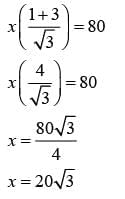
Height of the poles x = 20√3 m
Distance of the point O from the pole AB
Distance of the point O from the pole CD
OC = BC - BO
= 80 - 20
= 60
Height of the poles are 20√3 m and the distances of the point from the poles are 20m and 60m
Q11: A TV tower stands vertically on a bank of a canal. From a point on the other bank directly opposite the tower, the angle of elevation of the top of the tower is 60°. From another point 20 m away from this point on the line joining this point to the foot of the tower, the angle of elevation of the top of the tower is 30° (see figure). Find the height of the tower and the width of the canal.
Ans:
Known:
(i) The angle of elevation of the top of the tower from a point on the other bank directly opposite the tower is 60°
(ii) From another point 20 m away from this point in (i) on the line joining this point to the foot of the tower, the angle of elevation of the top of the tower is 30°
(iii) CD = 20 m
Unknown:
Height of the tower = AB and the width of canal = BC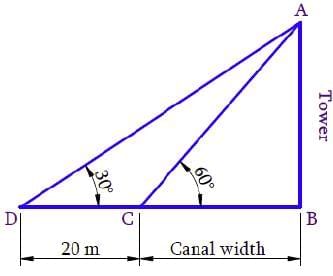 Reasoning:
Reasoning:
Trigonometric ratio involving CD, BC, angles and height of tower AB is tan q .
Solution:
Considering ΔABC,
Considering ΔABD,
Substituting BC = 10 m in Equation (1), we get
AB = 10√3 m
Height of the tower AB = 10√3 m
Width of the canal BC = 10 m
Q12: From the top of a 7 m high building, the angle of elevation of the top of a cable tower is 60° and the angle of depression of its foot is 45°. Determine the height of the tower.
Ans:
Known:
(i) Height of building = 7m
(ii) Angle of elevation of the top of a cable tower from building top = 60°
(iii) Angle of depression of the foot of the cable tower from building top = 45°
Unknown:
Height of the tower.
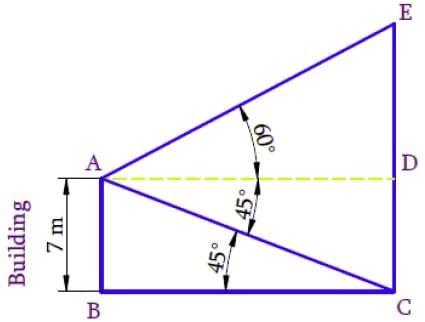
Reasoning: Let the height of the tower is CE and the height of the building is AB. The angle of elevation of the top E of the tower from the top A of the building is 60° and the angle of depression of the bottom C of the tower from the top A of the building is 45°.
Trigonometric ratio involving building height, tower height, angles and distances between them is tan θ
Solution:
Draw AD||BC.
Then, ∠DAC = ∠ACB = 45º (alternate interior angles.)
In ΔABC, ABCD is a rectangle,
ABCD is a rectangle,
Therefore, BC = AD = 7 and AB = CD = 7
In ΔADE,
Height of tower
CE = ED + CD
=7√3 + 7
=7(√3 + 1)
Height of the tower =7(√3 + 1) M
Q13: As observed from the top of a 75 m high lighthouse from the sea-level, the angles of depression of two ships are 30° and 45°. If one ship is exactly behind the other on the same side of the lighthouse, find the distance between the two ships.
Ans:
Known:
(i) Height of the lighthouse = 75 m
(ii) Angles of depression of two ships from the top of the lighthouse are 300 and 450
Unknown:
Distance between the two ships
 Reasoning:
Reasoning:
Let the height of the lighthouse from the sea-level is AB and the ships are C and D. The angles of depression of the ships C and D from the top A of the lighthouse, are 45° and 60° respectively.
Trigonometric ratio involving AB, BC, BD and angles is tan θ.
Distance between the ships, CD = BD − BC
Solution: In ΔABC,
In ΔABD,
Distance between two ships CD = BD− BC
CD = 75√3 - 75
= 75(√3 - 1)
Distance between two ships CD = 75(√3 - 1) m
Q14: A 1.2 m tall girl spots a balloon moving with the wind in a horizontal line at a height of 88.2 m from the ground. The angle of elevation of the balloon from the eyes of the girl at any instant is 60°. After some time, the angle of elevation reduces to 30° (see figure). Find the distance travelled by the balloon during the interval.
 Ans:
Ans:
Known:
(i) Height of the girl = 1.2 m
(ii) Vertical height of balloon from ground = 88.2 m
(iii) Angle of elevation of the balloon from the eyes of the girl is reducing from 60° to 30° as the balloon moves along wind.
(iv) From the figure, OD = BC can be calculated as
88.2 m – 1.2 m = 87 m---------------- Result (1)
Unknown:
Distance travelled by the balloon, OB
Reasoning:
Trigonometric ratio involving AB, BC, OD, OA and angles is tan θ . [Refer AB, BC, OA and OD from the figure.]
Distance travelled by the balloon OB = AB – OA
Solution:
From the figure, OD = BC, can be calculated as
88.2 m – 1.2 m = 87 m---------------- (1)
In ΔAOD,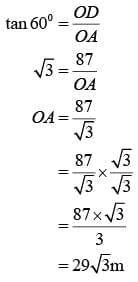
In ΔABC,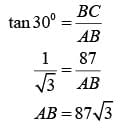
Distance travelled by the balloon, OB = AB – OA
OB = 87√3 - 29√3
=58√3
Distance travelled by the balloon = 58√3 m
Q15: A straight highway leads to the foot of a tower. A man standing at the top of the tower observes a car at an angle of depression of 30°, which is approaching the foot of the tower with a uniform speed. Six seconds later, the angle of depression of the car is found to be 60°. Find the time taken by the car to reach the foot of the tower from this point.
Ans:
Known:
(i) Angle of depression is 30°
(ii) 6 seconds later angle of depression is 60°
Unknown: Time taken by the car to reach the foot of the tower = CD
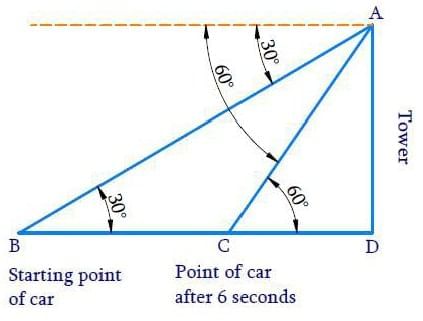
Reasoning:
Let the height of the tower as AD and the starting point of the car as B and after 6 seconds point of the car as C. The angles of depression of the car from the top A of the tower at point B and C are 30° and 60° respectively.
Distance travelled by the car from the starting point towards the tower in 6 seconds = BC
Distance travelled by the car after 6 seconds towards the tower = CD
Trigonometric ratio involving AD, BC, CD and angles is tan θ
We know that,
The speed of the car is calculated using the distance BC and time = 6 seconds. Using Speed and Distance CD, time to reach foot can be calculated.
Solution:
In ΔABD,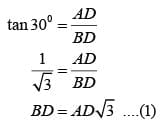
In ΔACD,
From equation (1) and (2)
Distance travelled by the car from the starting point towards the tower in 6 seconds = BC Speed of the car to cover distance BC in 6 seconds;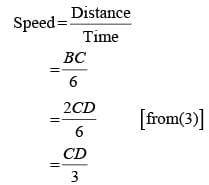
Speed of the car 
Distance travelled by the car from point C, towards the tower = CD
Time to cover distance CD at the speed of 

Time taken by the car to reach the foot of the tower from point C is 3 seconds.
|
127 videos|584 docs|79 tests
|
FAQs on NCERT Solutions for Class 10 Maths Chapter 9 - Some Applications of Trigonometry (Exercise 9.1)
| 1. What is the importance of trigonometry in real-life applications? |  |
| 2. How can trigonometric ratios be applied to find heights and distances? |  |
| 3. What are the different trigonometric ratios used in applications of trigonometry? |  |
| 4. Can trigonometry be used in everyday situations? |  |
| 5. How do you solve problems using trigonometric identities? |  |






















